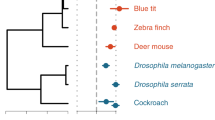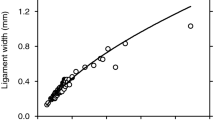Abstract
We re-examined data for field metabolic rates of varanid lizards and marsupial mammals to illustrate how different procedures for fitting the allometric equation can lead to very different estimates for the allometric coefficient and exponent. A two-parameter power function was obtained in each case by the traditional method of back-transformation from a straight line fitted to logarithms of the data. Another two-parameter power function was then generated for each data-set by non-linear regression on values in the original arithmetic scale. Allometric equations obtained by non-linear regression described the metabolic rates of all animals in the samples. Equations estimated by back-transformation from logarithms, on the other hand, described the metabolic rates of small species but not large ones. Thus, allometric equations estimated in the traditional way for field metabolic rates of varanids and marsupials do not have general importance because they do not characterize rates for species spanning the full range in body size. Logarithmic transformation of predictor and response variables creates new distributions that may enable investigators to perform statistical analyses in compliance with assumptions underlying the tests. However, statistical models fitted to transformations should not be used to estimate parameters of equations in the arithmetic domain because such equations may be seriously biased and misleading. Allometric analyses should be performed on values expressed in the original scale, if possible, because this is the scale of interest.




Similar content being viewed by others
References
Albrecht GH (1988) Simple allometry coefficients: fact or fiction. Am Zool 28:172A
Asselman NEM (2000) Fitting and interpretation of sediment rating curves. J Hydrol 234:228–248
Brown JH, Gillooly JF, Allen AP, Savage VM, West GB (2004) Toward a metabolic theory of ecology. Ecology 85:1771–1789
Calder WA III (1984) Size, Function, and Life History. Harvard University Press, Cambridge
Emerson JD, Stoto MA (1983) Transforming data. In: Hoaglin DC, Mosteller F, Tukey JW (eds) Understanding Robust and Exploratory Data Analysis. Wiley, New York, pp 97–128
Finney DJ (1989) Was this in your statistics textbook? V. Transformation of data. Exp Agric 25:165–175
Glass NR (1969) Discussion of calculation of power function with special reference to respiratory metabolism in fish. J Fish Res Bd Can 26:2643–2650
Hartwig F, Dearing BE (1979) Exploratory data analysis. Sage Publications, Beverly Hills
Hayes JP, Shonkwiler JS (2006) Allometry, antilog transformations, and the perils of prediction on the original scale. Physiol Biochem Zool 79:665–674
Hui D, Jackson RB (2007) Uncertainty in allometric exponent estimation: A case study in scaling metabolic rate with body mass. J Theoret Biol 249:168–177
Jansson M (1985) A comparison of detransformed logarithmic regressions and power function regressions. Geograf Annal 67A:61–70
Kutner MH, Nachtsheim CJ, Neter J (2004) Applied linear regression models, 4th edn. McGraw-Hill Irwin, Boston
LaBarbera M (1989) Analyzing body size as a factor in ecology and evolution. Annu Rev Ecol Syst 20:97–117
Manaster BJ, Manaster S (1975) Techniques for estimating allometric equations. J Morphol 147:299–308
Marquardt DW (1963) An algorithm for least-squares estimation of nonlinear parameters. J Soc Indust Appl Math 11:431–441
McCuen RH, Leahy RB, Johnson PA (1990) Problems with logarithmic transformations in regression. J Hydraul Eng 116:414–428
Miller DR (1984) Reducing transformation bias in curve fitting. Am Stat 38:124–126
Motulsky H, Christopoulos A (2004) Fitting models to biological data using linear and nonlinear regression. Oxford University Press, Oxford
Myers RH (1986) Classical and modern regression with applications. Duxbury Press, Boston
Nagy KA (2005) Field metabolic rate and body size. J Exp Biol 208:1621–1625
Nagy KA, Girard IA, Brown TK (1999) Energetics of free-ranging mammals, reptiles, and birds. Annu Rev Nutr 19:247–277
Osborne JW (2002) Notes on the use of data transformations. Pract Assess Res Eval 8(6)
Packard GC, Boardman TJ (2008a) Model selection and logarithmic transformation in allometric analysis. Physiol Biochem Zool 81:496–507
Packard GC, Boardman TJ (2008b) Bias in interspecific allometry: examples from morphological scaling in varanid lizards. Biol J Linn Soc (in press)
Pandey GR, Nguyen V-T-V (1999) A comparative study of regression based methods in regional flood frequency analysis. J Hydrol 225:92–101
Peters RH (1983) The Ecological Implications of Body Size. Cambridge University Press, Cambridge
Savage VM, Gillooly JF, Woodruf WH, West GB, Allen AP, Enquist BJ, Brown JH (2004) The predominance of quarter-power scaling in biology. Funct Ecol 18:257–282
Schmidt-Nielsen K (1984) Scaling/why is animal size so important? Cambridge University Press, Cambridge
Smith RJ (1984) Allometric scaling in comparative biology: problems of concept and method. Am J Physiol 246:R152–R160
Smith RJ (1993) Logarithmic transformation bias in allometry. Am J Phys Anthropol 90:215–228
Snee RD (1977) Validation of regression models: methods and examples. Technometrics 19:415–428
West GB, Brown JH (2005) The origin of allometric scaling laws in biology from genomes to ecosystems: towards a quantitative unifying theory of biological structure and organization. J Exp Biol 208:1575–1592
White CR, Seymour RS (2005) Allometric scaling of mammalian metabolism. J Exp Biol 208:1611–1619
Zar JH (1968) Calculation and miscalculation of the allometric equation as a model in biological data. Bioscience 18:1118–1120
Acknowledgments
We are grateful to Martin Feder, Albert Bennett, Warren Burggren, and Raymond Huey for encouraging us to undertake a critical evaluation of the methods of allometry. We also thank Geoffrey Birchard and two anonymous referees for helpful comments on the manuscript.
Author information
Authors and Affiliations
Corresponding author
Additional information
Communicated by I. D. Hume.
Rights and permissions
About this article
Cite this article
Packard, G.C., Boardman, T.J. A comparison of methods for fitting allometric equations to field metabolic rates of animals. J Comp Physiol B 179, 175–182 (2009). https://doi.org/10.1007/s00360-008-0300-x
Received:
Revised:
Accepted:
Published:
Issue Date:
DOI: https://doi.org/10.1007/s00360-008-0300-x




